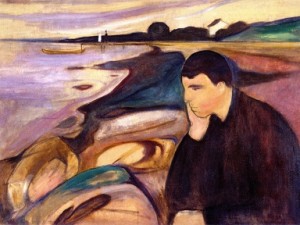‘The Scream’ of meaninglessness
Edvard Munch (1863-1944)
By Cecilie Nyman
When I saw Edvard Munch’s iconic expressive horror painting ’ The Scream’ for the first time, depicted in a school book, I was too young to understand this raw and somber piece of art. I found the painting fascinating, but to be honest – quite ugly. I knew nothing about suffering souls; they didn’t exist in my safe childhood.
But on the bumpy road, I have come to meet a million faces – I have met the suffering souls. ‘The Scream’ contains all horror, illness, anxiety and pain – then, now and for eternity.
The lines are wavy like tongues, the colors in the sky are burning, the nature is dark and disturbing. Munch writes in his diary about his terrifying experience that led to ‘The Scream’. He was walking along a path…
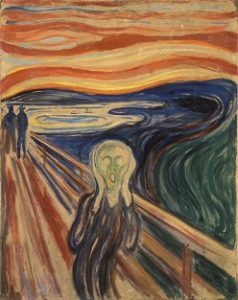
… ‘I was walking along a path with two friends – the sun was setting – suddenly the sky turned blood red – I paused, feeling exhausted, and leaned on the fence, there was blood and tongues of fire above the blue black fjord and the city – and I sensed an infinite scream passing through nature.’ – Edvard Munch.
In his childhood, Edvard Munch was often ill and kept out of school. He spent hours drawing. He lost his mother at five and his favorite sister in a young age. Another sister was suffering from severe mental illness. His brother died 30 years old. Edvard’s childhood was poisoned by illness and death. Furthermore, Edvard’s father was an unpredictable, religious fanatic and a permanent threat to Edvard. The father told ghost stories, like the tales by Edgar Allen Poe, which gave the fragile Edvard terrible nightmares and paranoid visions of death. Dark motives of illness, death and loneliness were created in Edvard’s childhood and expressed in his work in the years to come.
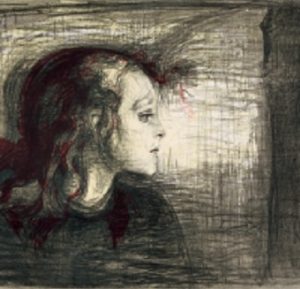
‘My fear of life is necessary to me, as is my illness. Without anxiety and illness, I am a ship without a rudder. My art is grounded in reflections over being different from others. My sufferings are part of myself and my art. They are indistinguishable from me, and their destruction would destroy my art, I want to keep those sufferings.’
– Edvard Munch
In the years 1892 to 1908, Munch spent most of his time in Paris and Berlin. The first visits to Paris inspired Munch to paint impressionist, pleasant interiors with knitting women. But he felt limited by the Impressionism and Realism and came to feel greatly affected by the Post-Impressionists, Vincent van Gogh and Gauguin. Munch wanted to paint living people who breathe and feel and suffer and love. Munch wanted to express the subjective deeper layers, the subconscious, through expressive colors, composition and raw brushwork. He adopted Gauguin’s large areas of color with heavy outlines – especially characteristic in Munch’s extremely captivating prints. Munch’s sufferings were his prime painting motor. He transformed pain into expressive art.
The 1890s were the peak of Munch’s art. His symbolist and expressive art became widely appreciated and he achieved great success. But despite his success, Munch was a suffering and tortured soul affected by his childhood of illness, loss and anxiety. Furthermore, his love life was a disaster and he suffered from paranoia. Munch was drowning in misery, and alcohol. In 1908 he had a nervous breakdown, which led to hospitalization.
After a longer stay at a nursing home in Denmark, Edvard turned back to life as a healthier man and his art became more cheerful. The treatment had made it possible for him to live, but more difficult to invent art. Expressing the darkest and deepest feelings was unique for Munch. On his recovery the colors became lighter and brighter. Instead of painting an inner somber chaos, Edvard searched for more optimistic and universal symbols, like ‘The Sun’, rising with hope for a brighter future.
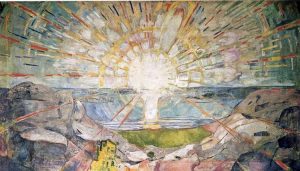
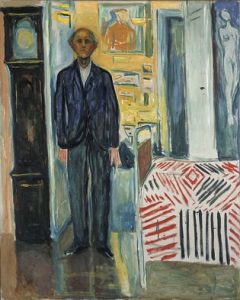
Munch lived the last two decades of his life in Norway in relative isolation. He painted expressive self-portraits, landscapes and scenes of workers, but fewer new insights, revelations and expressive explorations of the psychic nature of being. Edvard Munch died in 1944.
‘All important things in art have always originated from the deepest feeling about the mystery of Being.’ – Emil Nolde
Edvard Munch played a great role in German Expressionism, and in the art form that later followed. Next time I will visit the German Expressionists!
